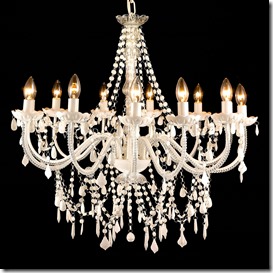Chandeliers as they are became known in the English language in 1736. The word originated from the Old French word which comes from the Latin “candelabrum”.
 Chandeliers have been around for a long time, but they were first seen in the medieval times. They were used by the wealthy to show their power and status. These first chandeliers were candle chandeliers. It wasn’t until the 15th century when different designs started to be produced and made. From then, there was a large variety of designs which were based on ring or crowns; these were symbolic and were often seen in richer houses – houses of nobility, palaces or clergy and merchants.
Chandeliers have been around for a long time, but they were first seen in the medieval times. They were used by the wealthy to show their power and status. These first chandeliers were candle chandeliers. It wasn’t until the 15th century when different designs started to be produced and made. From then, there was a large variety of designs which were based on ring or crowns; these were symbolic and were often seen in richer houses – houses of nobility, palaces or clergy and merchants.
The designs of chandeliers were adapted and progressed and in the 18th century the change of design was evident; the curved arms and many more candles in the design were seen. They were even beginning to be placed in the homes of those who weren’t of upper class, but of the working class.
Greek and Roman influences became popular in chandeliers and neoclassical elements were also adapted into designs. They were made from cast metals and the designs carved and gilded into wood. Clean cut lines and mythological creatures and symbols were highly popular and taken from this era. It was around this time when the Crystal Chandelier started to be produced because of the glassmaking introduction into society and the cheaper and quicker production that became possible.
Glass Chandeliers were created and produced by Bohemian and Venetian glassmakers; Bohemian style chandeliers were more popular in Europe especially with the way the designs refracted light with the crystal positioning.
 These designs were then developed with the introduction of Murano glass; this then added even more depth to chandeliers. Murano glass wasn’t as popular as crystals though because it wasn’t suitable for faceting and didn’t refract the light as effectively. The typical attributes of Murano chandeliers are the detailed leaves, flowers and fruits which would be made even more effective by the different colour glass. Their main attribute was their originality. This fundamental design was then developed into “ciocca” which has characteristics to a bouquet of flowers and took the designs made from Murano glass chandeliers and developed them further. Murano glass chandeliers were mainly used in palaces and theatres; places where colour would make an addition and complement its surroundings.
These designs were then developed with the introduction of Murano glass; this then added even more depth to chandeliers. Murano glass wasn’t as popular as crystals though because it wasn’t suitable for faceting and didn’t refract the light as effectively. The typical attributes of Murano chandeliers are the detailed leaves, flowers and fruits which would be made even more effective by the different colour glass. Their main attribute was their originality. This fundamental design was then developed into “ciocca” which has characteristics to a bouquet of flowers and took the designs made from Murano glass chandeliers and developed them further. Murano glass chandeliers were mainly used in palaces and theatres; places where colour would make an addition and complement its surroundings.
In the mid 19-century was when chandeliers completely changed; they were no longer used with candles because of the revelation of gas lighting. Candle chandeliers were converted to be used with gas. It was in the 1890’s with the introduction of electric light when some chandeliers could be used with both. As the use of electricity widened, chandeliers were gradually made to only be used in association with electricity. They do however emulate the candle chandeliers with the use of candle bulbs; this gives an original and authentic look while still keeping the chandeliers looking historical. Chandeliers are essentially timeless.

Leave a Reply